Table of Contents

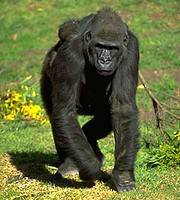
Gorilla gorilla gorilla © 2001 California Academy of Sciences
- Introduction
- Building on the Mammal Pattern (with mammal images)
- Table of Mammal Characteristics
- What Makes a Primate a Primate?
- Skeletal Features of Primates (with primate images)
- Primate Evolutionary Trends (with primate images)
- Primate Behavior (with primate images)
Introduction
Maybe you just watched a film about Madagascar and met some lemurs jumping and running through the forest. Maybe you visited the zoo and saw gorillas grooming each other and eating leaves. Maybe you passed an elementary school and saw kids swinging on the monkey bars. Or maybe you just looked at your thumb as you picked up a carrot to eat it and thought “wow, that’s pretty cool I can pick things up like that!” In all these scenarios, you are contemplating what it means to be a primate.
Building on the Mammal Pattern
One of the important things to know as we ask “what makes a primate a primate” is that the primate characteristics we see are all built on mammal characteristics. All primates are mammals. This means that based on what we know about mammals, we can assume some basic things about how primates are put together, how they function, and what they do. Four kinds of mammals are pictured below so when you look at the table below about mammal characteristics, you will be able to look for those traits in these pictures.
 Click on an image to view larger version & data in a new window 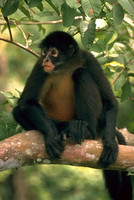 Ateles (Red Spider Monkey) shows thermoregulation by his hair for insulation and by sitting in the shade, showing he does not need the sun to maintain body temperature © 2001 California Academy of Sciences |  Click on an image to view larger version & data in a new window 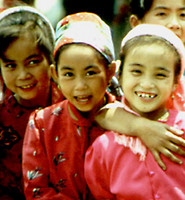 Homo sapiens (Human) children, in the childhood stage unique to humans, are showing their first set of teeth (baby teeth) the first of two sets mammals have to promote nutritional efficiency © 1993 Ethan Michelson |
 Click on an image to view larger version & data in a new window 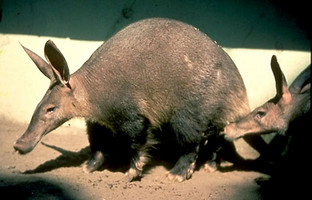 Orycteropus afer (Aardvark) shows one way of moving - quadrupedally, or on four limbs. How do these other mammals move? © 2001 California Academy of Sciences |  Click on an image to view larger version & data in a new window 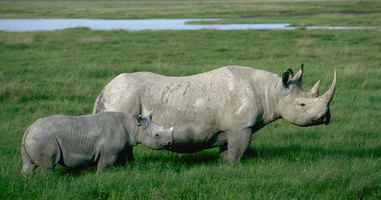 Diceros bicornis (Black rhinoceros) Notice the environment these rhinos occupy and think about the different environments that are illustrated in these pictures that can all be occupied by mammals © 2000 Greg and Marybeth Dimijian |
Table of Mammal Characteristics
| Trait | This means they can | They have |
|---|---|---|
| Thermoregulation | Maintain and change body temperature | Hair to insulate, sweat glands to cool off, and are “warm-blooded” so unlike reptiles, they don’t have to be in a sunny spot to stay warm |
| Nutritional Efficiency | Eat and digest a lot to keep themselves going | A hard palate that divides chewing and breathing apparatus so they can eat and breathe at the same time, two sets of teeth over the lifetime and several different kinds of teeth for different functions |
| Locomotion and Posture | Move in many different ways | A variety of options when traveling through the environment and seeking food |
| Multiple, Developed Life Stages | Spread growth and development over a longer period | Four main stages:
|
| Behavioral Flexibility | Change behavior to cope with changes in the environment | A better chance of using resources, surviving and reproducing due to larger brains |
See Morbeck, Galloway and Zihlman's book The Evolving Female for more on what it means to be a mammal and how primates build on those mammal characteristics.
What Makes a Primate a Primate?
We look at 3 kinds of evidence:
- Skeletal Features
- Primate Evolutionary Trends
- Primate Behavior
Note: The primate characterisitics below are drawn mainly from Falk's Primate Diversity, with additional information from Fleagle's Primate Adaptation and Evolution.
Skeletal Features Related to Teeth and Snout
- Shortened snout
- Why? Primates rely less on their sense of smell and more on vision. Primates also have a reduced number of teeth as compared to other mammals.
- Several types of teeth: incisors, canines, premolars, molars
- Why? With different types of teeth, they can eat a variety of foods and process food efficiently. They have incisors for biting, canines for shearing and premolars and molars for crunching food into digestable packages.
 Click on an image to view larger version & data in a new window 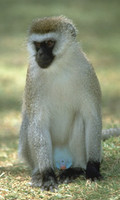 Cercopithecus aethiops (Vervet or Green Monkey). Notice his small snout © 1999 Greg and Marybeth Dimijian |  Click on an image to view larger version & data in a new window 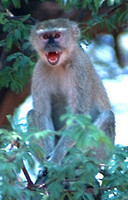 Cercopithecus aethiops (Vervet or Green Monkey). Notice this monkey's tooth display, showing off canine teeth © 2000 Greg and Marybeth Dimijian |
Skeletal Features Related to Eyes and Ears
- Forward facing eye orbits
- Why? Primates have an increased emphasis on vision, so natural selection acted to position the eyes best for taking in the most visual stimuli.
- Stereoscopic vision
- Why? Stereoscopic vision means that the fields of vision provided by each eye overlap, resulting in what's called depth perception. This is extremely useful for forest-dwelling primates, as it lets them judge how far away the next branch is as they are moving from tree to tree.
- Three bones of the middle ear housed in a skull outgrowth (the auditory or petrosal bulla)
Skeletal Features Related to Arms and Legs
- Clavicles (collarbones)
- Why? Primates have very extensive shoulder motion because the clavicle provides the only bony link between the upper limb and the trunk.
- Two separate bones in the forearm and lower leg
- Why? Having two bones allows for better limb motion and more precise movements.
Skeletal Features Related to Fingers and Toes
- Nails instead of claws
- Why? Nails allow primates to manipulate objects more easily.
- Increased thumb mobility
- Why? Again, related to manipulating objects. As you move across the primate order from lemurs and lorises to great apes, including humans, the thumb becomes more and more mobile
- Grasping feet
- Why? Primates have more big toe mobility for grasping and climbing. The only exception is humans (Homo sapiens). We have lost the grasping ability in our feet because our feet are designed to serve as a platform for walking
 Click on an image to view larger version & data in a new window 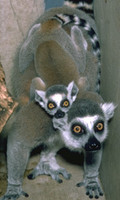 Lemur catta (Ring-tailed lemur) Look at the grasping hands and feet on this mother lemur. Her baby also has good grasping ability, as it hangs on to mom's back as she travels © 2000 Greg and Marybeth Dimijian |
Primate Evolutionary Trends
- Trend toward more vertical posture
- Why? Primates tend to move with a more vertical posture, even if they are rarely upright.
- Trend toward different use of forelimbs and hindlimbs
- Why? Primates use their limbs for more than just locomotion (moving around)
- Trend toward longer lives with longer periods of infancy, childhood and adulthood
- Why? Longer lives and longer life stages are good for increased growth, especially brain growth. Primates have larger brains for their body size than a lot of other mammals, and are born with brains that still need to develop quite a bit outside of the mother’s body. Primates also spend a lot of time learning skills and strategies for food gathering and survival from their mothers and others in their social groups.
- Trend toward enlarged brains with increased areas for vision and reduced areas for olfaction
 Click on an image to view larger version & data in a new window 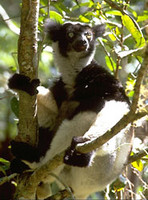 Indri indri (Indri) Though this indri moves by clinging to tree trunks and using powerful hindlimbs to leap from tree to tree, it maintains the more vertical posture seen in many primates © 2000 California Academy of Sciences |  Click on an image to view larger version & data in a new window 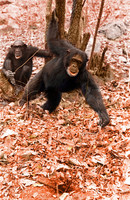 Pan troglodytes schweinfurthii (Common chimpanzee) The chimpanzee in the foreground of the photo is using its hindlimbs to stand upright and its forelimbs to insert a stick into a termite nest (in the very front of the photo) to capture the termites to eat © 2005 David Bygott |
Primate Behavior
So what do primates DO that makes them primates? They spend time:
- Using their limbs to climb in trees by grasping with hands and feet
- Using their hands to bring food to their mouth for feeding
- Being a part of social group life, building and reinforcing bonds between individuals and learning from their mothers and others
 Click on an image to view larger version & data in a new window 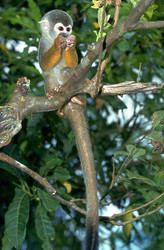 Saimiri sciureus (Squirrel monkey) Look at how this monkey is bringing food to its mouth with its hands © 2001 California Academy of Sciences | |
 Click on an image to view larger version & data in a new window 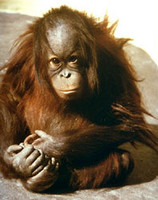 Pongo pygmaeus (Orangutan) Orangutans rely solely on their mothers to teach them how to survive in the world. It is typical for an orangutan to stay with its mother until it is 7 years old © 2001 California Academy of Sciences |
Information on the Internet
- Primate Info Net A searchable database of primate information run by the University of Wisconsin
- The Primates Topic Menu Clearly organized information about the Order Primates with information pages, flash cards to review information and interactive crossword puzzles to test your new knowledge
- Animal Diversity Web: Order Primates A comprehensive site with information about primates as well as many images of primates, specimens (for example, photographs of primate skulls and jaws) and sounds made by primates.
- Valley Zoo School Primate Research Results Information on five kinds of primates as well as classification information and some primate links put together by a Canadian primary school. Also has teacher resources like a kid-friendly primate observation sheet on the school's home page.
- Gombe Page Several fun chimp and primate-themed quizzes along with video clips of Jane Goodall greeting an audience with chimp sounds and talking about the Gombe chimpanzees.
- Jane Goodall Institute Chimpanzee Central Information about chimpanzees, part of the Jane Goodall Institute site.

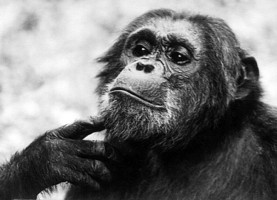
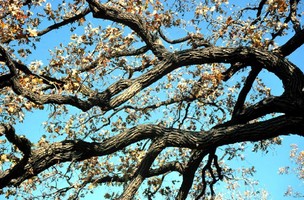
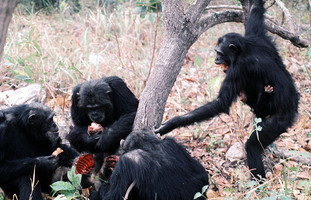
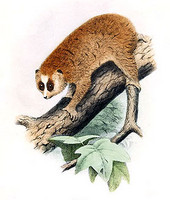
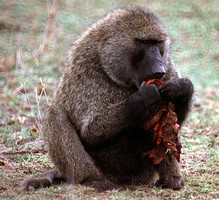
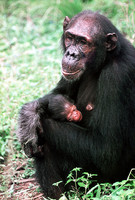
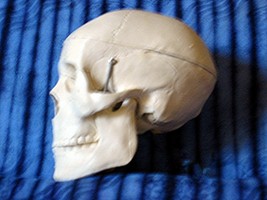
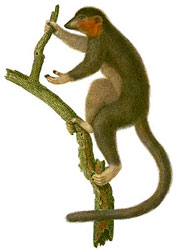
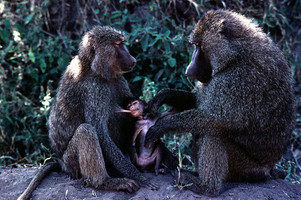



 Go to quick links
Go to quick search
Go to navigation for this section of the ToL site
Go to detailed links for the ToL site
Go to quick links
Go to quick search
Go to navigation for this section of the ToL site
Go to detailed links for the ToL site